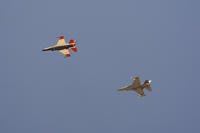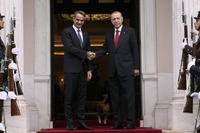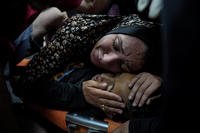They've served, mostly, as spies. Once in a great while, they've moonlighted as assassins. But now, unmanned aircraft are slowly starting to become full-fledged killing machines -- armed to the teeth, and designed for the deadliest parts of war.
In just five years, the U.S. military wants a handful of fighting drones ready to take into battle. This week, in a hotel ballroom just a few miles from the Pentagon, a group of a hundred or so Defense Department officials and military contractors laid out their roadmap for how they'll reach this goal.
Drones have quickly become a central part of U.S. military efforts because they can hang over a combat zone for hours on end. A flesh-and-blood pilot poops out after about 10 hours; some robotic planes can stay aloft for more than three times that amount.
In Pentagon-ese, this is known as "persistence." The Defense Department would like to shift from persistent surveillance -- which the drones are now starting to provide -- to an always-on ability to kill, should an adversary pop up in a pilotless plane's sights.
"The idea is to be there when targets present themselves," said Northrop Grumman program manager Scott Winship told the group gathered for the "Combat UAV 2004" conference here.
My Wired News article has details.
THERE'S MORE: A year ago next week, Saddam Hussein was ousted by more than a hundred thousand allied troops and a few dozen robotic planes. At the conference on Tuesday, Pentagon officials detailed the drones' critical roles in the invasion and occupation of Iraq.
Predator spy drones kept watch as U.S. forces captured Saddam Hussein, Air Force Major General Ronald Sams told the group. One of the planes, operated by pilots at Nellis Air Force Base in Nevada, destroyed the Iraqi television center, ending the comical broadcasts of Saddam's information minister, Mohammed Saeed al-Sahaf, known in the States as "Baghdad Bob." Other UAVs have tracked down insurgents firing mortars at American troops, spotted camouflaged missile batteries, and looked over the rescue of Pfc. Jessica Lynch, Sams said.
Predators have flown 574 sorties, for more than 6,927 and a half hours, during Operation Iraqi Freedom. But it's one of at least 10 American drones that have seen action in Iraq.
The high-flying Global Hawk UAVs have only been on 15 sorties. But the long-endurance planes have taken nearly 3,000 pictures of time-sensitive targets.
On the 25th of March, 2003, for example, sand storms prevented Iraqi troops (and many Americans) from seeing "their hands in front of their faces," Sams recounted. But, using infrared sensors, the Global Hawk was able to take pictures of the Medina Republican Guard division. Those images were sent back to the United States via satellite for processing. Minutes later, American airmen were given the division's coordinates, and were able to strike.
All in all, Global Hawk lead to the destruction of 300 tanks -- 38% of Iraq's armored forces - said Dyke Weatherington, who serves as the deputy director of the Defense Secretary's task force for unmanned planes.
Generals were and continue to be enthralled by the big drones. But, to the average grunt, these UAVs didn't mean a whole lot. Even 17 foot-wide Pioneer UAV just a fraction of the Global Hawk's size often seemed out of reach to those who needed it most.
"The Pioneer worked great when the bureaucracy could be negotiated," reads an "after action" report from the 1st Marine Division. However, "the byzantine collections process inhibited our ability to get timely responses to combat requirements... The Division found the enemy by running into them, much as forces have done since the beginning of warfare."
Soldiers and Marines often had better experiences with the tiniest of drones the ones that could be launched with a good, hard throw. One seven pound Desert Hawk UAV recently found a cache of 107 mm anti-aircraft guns outside on an American base, Sams noted. Another spotted a group of weapons-toting Iraqi insurgents outside a U.S. encampment.
AND MORE: Thanks to DARPA, Video from a recent UCAV test is here.
KILLER DRONE PLANS REVEALED
© Copyright 2024 Military.com. All rights reserved. This article may not be republished, rebroadcast, rewritten or otherwise distributed without written permission. To reprint or license this article or any content from Military.com, please submit your request here.








